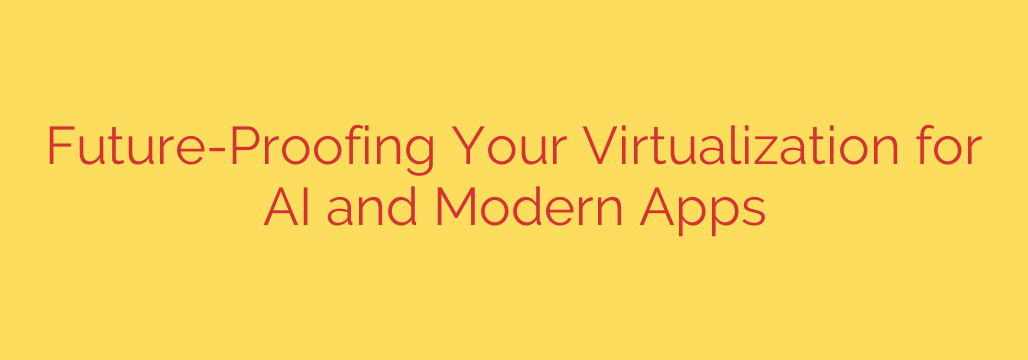
Is Your Virtualization Ready for AI? How to Future-Proof Your Infrastructure
The landscape of enterprise IT is undergoing a seismic shift. For years, virtualization has been the bedrock of the data center, delivering unparalleled efficiency and reliability. But the rise of Artificial Intelligence (AI), Machine Learning (ML), and modern, cloud-native applications presents a new set of demands that traditional infrastructure was not designed to handle.
The core question for IT leaders today is no longer if these new workloads will arrive, but how to support them effectively. Ripping and replacing your trusted virtualization platform isn’t a viable option. The key is to evolve and adapt. This guide outlines the essential strategies for future-proofing your virtualization environment to confidently run the next generation of business-critical applications.
The New Challenge: Why Modern Workloads Stretch Traditional VM Platforms
Virtualization platforms were perfected for running stable, monolithic applications in virtual machines (VMs). This model excels at isolating operating systems and managing resources for predictable software. However, today’s demanding workloads operate on a completely different level.
- AI and ML Workloads: These are not your typical enterprise apps. They require massive parallel processing capabilities, direct access to specialized hardware like GPUs, and extremely high-throughput, low-latency access to enormous datasets.
- Cloud-Native and Containerized Applications: Built on principles of microservices and managed by orchestrators like Kubernetes, these applications are dynamic, ephemeral, and distributed. They demand network agility and a management approach that understands containers, not just VMs.
Trying to force these powerful new applications onto an unprepared virtualization stack leads to performance bottlenecks, management complexity, and stalled innovation.
Key Strategies for Modernizing Your Virtual-First Environment
To bridge the gap between your current infrastructure and future needs, focus on integrating key technologies that enhance, rather than replace, your existing platform.
1. Embrace High-Performance Hardware and GPU Virtualization
AI and ML models live and die by their access to Graphics Processing Units (GPUs). Simply placing a GPU in a server is not enough; you must be able to manage and allocate its power efficiently.
GPU virtualization (vGPU) is the cornerstone of this strategy. Technologies like NVIDIA vGPU and AMD MxGPU allow a single physical GPU to be partitioned into multiple virtual GPUs. Each vGPU can then be assigned directly to a specific VM. This provides the near-bare-metal performance required for model training and inference while retaining the management benefits of virtualization.
Actionable Tip: Move beyond basic GPU passthrough. Implement a robust vGPU management strategy to ensure you can share these expensive resources across multiple projects and teams, maximizing your hardware investment and avoiding resource silos.
2. Unify Virtual Machines and Containers on a Single Platform
The debate is not about “VMs vs. Containers.” The reality is that enterprises will run both for the foreseeable future. The most efficient path forward is to run them together on a unified platform.
Modern virtualization solutions are now deeply integrated with Kubernetes. This allows you to run containers inside specialized, lightweight VMs or directly on hypervisor-level clusters. The benefit is immense: your teams can use familiar tools to manage both legacy applications and new, containerized microservices from a single control plane. This eliminates infrastructure silos, simplifies operations, and allows developers to use the best architecture for the job without creating management headaches.
3. Re-Architect Your Network and Storage for Speed
AI workloads are incredibly data-intensive, and legacy network and storage architectures are often the first bottleneck to appear.
- Networking: The sheer volume of data processed during AI model training can overwhelm traditional 10/25GbE networks. To handle this, organizations are turning to Data Processing Units (DPUs) and SmartNICs. These intelligent network adapters offload networking, storage, and security tasks from the CPU, freeing up its cores to focus purely on the application’s computational work.
- Storage: AI needs fast access to data. Software-defined storage (SDS) solutions built on high-performance hardware like NVMe flash are essential. Technologies like NVMe-over-Fabrics (NVMe-oF) extend this performance across the network, providing the low-latency data access that modern applications demand.
4. Adopt a Modern, Granular Security Model
In a world of distributed microservices, the traditional “castle-and-moat” security model is obsolete. With countless services communicating with each other (known as east-west traffic), the attack surface is much larger.
Future-proofing your infrastructure requires a move toward a zero-trust security model. Micro-segmentation is a critical component of this approach. By using the hypervisor to enforce security policies at the individual workload level, you can create a secure boundary around every VM and container. This ensures that even if one component is compromised, the breach is contained and cannot spread laterally across your network. Intrinsic security, built directly into the virtualization layer, provides a far more granular and effective defense than legacy, perimeter-based firewalls alone.
Building a Resilient Foundation for Tomorrow
The era of AI and modern apps doesn’t spell the end for virtualization. On the contrary, it marks its evolution. By strategically enhancing your platform with GPU support, unified container management, high-performance networking, and intrinsic security, you can transform it into a powerful engine for innovation.
This approach allows you to leverage your existing investments and skills while building a flexible, secure, and high-performance foundation capable of supporting whatever business challenges come next.
Source: https://feedpress.me/link/23532/17174551/is-your-virtualization-ready-for-the-future-of-ai-and-modern-applications








